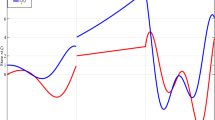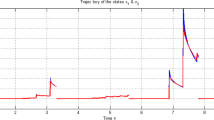Abstract
In this paper, a continuous approximation to studying a class of PWC systems of fractional-order is presented. Some known results of set-valued analysis and differential inclusions are utilized. The example of a hyperchaotic PWC system of fractional order is analyzed. It is found that without equilibria, the system has hidden attractors.












Similar content being viewed by others

Notes
Graphically, by approximation one understands that not all graphic points of the PWC function to be approximated need to be located on the created figure, compared with interpolation where all graphic points of the PWC function have to be located on the created figure.
See also [12], where several PWC and non-smooth jerk systems are proposed.
Sigmoid functions include the ordinary arctangent such as \(\frac{2}{\pi }\arctan \frac{x}{\varepsilon }\), the hyperbolic tangent used especially in modeling neural networks (see, e.g., [17]), the logistic function, some algebraic functions like \(\frac{x}{\sqrt{\epsilon +x^2}}\), and so on.
Since \(s_i\) are PW constant functions on \(x\ne 0\), they are differentiable on \(x\ne 0\).
The predictor-corrector ABM method has an error which is roughly proportional to \(h^2\). Thus, to obtain an error of, e.g., \(1.0e-6\), which is sufficient in applications, a step size close to \(h=1.0E-3\) must be considered.
As is well known, ODEs with \(C^k\) class right-hand side have \(C^{k+1}\) solutions.
References
Podlubny, I.: Fractional Differential Equations. Academic Press, San Diego (1999)
Zhou, Y.: Fractional Evolution Equations and Inclusions: Analysis and Control. Academic Press, Amsterdam (2016)
Stuart, A., Humphries, A.R.: Dynamical Systems and Numerical Analysis. Cambridge University Press, Cambridge (1998)
Dieci, L., Lopez, L.: A survey of numerical methods for IVPs of ODEs with discontinuous right-hand side. J. Comput. Appl. Math. 236(16), 3967–3991 (2012)
Diethelm, K., Ford, N.J., Freed, A.D.: A predictor-corrector approach for the numerical solution of fractional differential equations. Nonlinear Dyn. 29(1), 3–22 (2002)
Diethelm, K.: Efficient solution of multi-term fractional differential equations using \(\text{ P(EC) }^{m}\text{ E }\) methods. Computing 71(4), 305–319 (2003)
Dorcak, L.: Numerical models for the simulation of the fractional-order control systems. arXiv:math/0204108 [math.OC], arXiv:math/0204108v1 (2015)
Dontchev, A., Lempio, F.: Difference methods for differential inclusions: survey. SIAM Rev. 34(2), 263–294 (1992)
Acary, V., Brogliato, B.: Numerical Methods for Nonsmooth Dynamical Systems: Applications in Mechanics and Electronics. Lecture Notes in Applied and Computational Mechanics. Springer, New York (2008)
Lempio, F., Veliov, V.M.: Discrete approximations of differential inclusions. Bayreuther Mathematische Schriften 54, 149–232 (1998)
Li, C., Sprott, J.C., Thio, W., Zhu, H.: A new piecewise linear hyperchaotic circuit. IEEE Trans. Circuits Syst. II Express Briefs 61(12), 977–981 (2014)
Li, C., Sprott, J.C., Xing, H.: Hypogenetic chaotic jerk flows. Phys. Lett. Sect. A Gen. At. Solid State Phys. 380(11–12), 1172–1177 (2016)
Filippov, A.F.: Differential Equations with Discontinuous Right-Hand Sides. Kluwer Academic, Dordrecht (1988)
Ważewski, T.: On an optimal control problem. In: Differential Equations and Their Applications. Proceedings of the Conference, Prague, 1962, pp. 229–242. Publishing House of the Czechoslovak Academy of Sciences (1963)
El-Sayed, A.M.A., Ibrahim, A.G.: Multivalued fractional differential equations. Appl. Math. Comput. 68(1), 15–25 (1995)
Danca, M.-F.: Lyapunov exponents of a class of piecewise continuous systems of fractional order. Nonlinear Dyn. 81(1), 227–237 (2015)
Danca, M.-F., Kuznetsov, N.V.: Hidden chaotic sets in a Hopfield neural system. Chaos Solitons Fractals 103, 144–150 (2017)
Benchohra, M., Hamidi, N.: Fractional order differential inclusions on the half-line. Surv. Math. Appl. 5, 99–111 (2010)
Garrappa, R.: Predictor-corrector PECE method for fractional differential equations. https://www.mathworks.com/matlabcentral/fileexchange/32918-predictor-corrector-pece-method-for-fractional-differential-equations
Sarra, S.A., Meador, C.: On the numerical solution of chaotic dynamical systems using extend precision floating point arithmetic and very high order numerical methods. Nonlinear Anal. Model. Control 16(3), 340–352 (2011)
Wang, P., Li, J., Li, Q.: Computational uncertainty and the application of a high-performance multiple precision scheme to obtaining the correct reference solution of Lorenz equations. Numer. Algorithms 59(1), 147–159 (2012)
Liao, S.J., Wang, P.F.: On the mathematically reliable long-term simulation of chaotic solutions of Lorenz equation in the interval [0, 10000]. Sci. China Phys. Mech. Astron. 57(2), 330–335 (2014)
Yu, S., Lu, J., Leung, H., Chen, G.: Design and implementation of n-scroll chaotic attractors from a general jerk circuit. IEEE Trans. Circuits Syst. I Regul. Pap. 52(7), 1459–1476 (2005)
Kaslik, E., Sivasundaram, S.: Non-existence of periodic solutions in fractional-order dynamical systems and a remarkable difference between integer and fractional-order derivatives of periodic functions. Nonlinear Anal. Real World Appl. 13(3), 1489–1497 (2012)
Tavazoei, M.S., Haeri, M.: A proof for non existence of periodic solutions in time invariant fractional order systems. Automatica 45(8), 1886–1890 (2009)
Shen, J., Lam, J.: Non-existence of finite-time stable equilibria in fractional-order nonlinear systems. Automatica 50(2), 547–551 (2014)
Yazdani, M., Salarieh, H.: On the existence of periodic solutions in time-invariant fractional order systems. Automatica 47(8), 1834–1837 (2011)
Kang, Y.-M., Xie, Y., Lu, J.-C., Jiang, J.: On the nonexistence of non-constant exact periodic solutions in a class of the Caputo fractional-order dynamical systems. Nonlinear Dyn. 82(3), 1259–1267 (2015)
Duan, J.-S.: The periodic solution of fractional oscillation equation with periodic input. Adv. Math. Phys. 2013, 6 pages (2013)
Danca, M.-F., Fečkan, M., Chen, G.: Impulsive stabilization of chaos in fractional-order systems. Nonlinear Dyn. 89(3), 1889–1903 (2017)
Besicovitch, A.S.: Almost Periodic Functions. Cambridge University Press, Cambridge (1932)
Kuznetsov, N.V., Leonov, G.A., Vagaitsev, V.I.: Analytical-numerical method for attractor localization of generalized Chua’s system. IFAC Proc. 43(11), 29–33 (2010)
Leonov, G.A., Kuznetsov, N.V., Vagaitsev, V.I.: Localization of hidden Chua’s attractors. Phys. Lett. A 375(23), 2230–2233 (2011)
Leonov, G.A., Kuznetsov, N.V., Vagaitsev, V.I.: Hidden attractor in smooth Chua systems. Physica D Nonlinear Phenom. 241(18), 1482–1486 (2012)
Leonov, G.A., Kuznetsov, N.V.: Hidden attractors in dynamical systems. From hidden oscillations in Hilbert-Kolmogorov, Aizerman, and Kalman problems to hidden chaotic attractors in Chua circuits. Int. J. Bifurc. Chaos 23(1), 69 (2013). art. no. 1330002
Pham, V.-T., Volos, C., Kapitaniak, T.: Systems without equilibrium (Chapter). In: Ligi, F., Guanrong, C. (eds.) Systems with Hidden Attractors Springer Briefs in Applied Sciences and Technology, pp. 51–63. Springer International Publishing, Cham, Switzerland (2017)
Molaie, M., Jafari, S., Sprott, J.C., Golpayegani, S.M.R.H.: Simple chaotic flows with one stable equilibrium. Int. J. Bifurc. Chaos 23(11), 7 (2013). art. no. 1350188
Borah, M., Roy, B.K.: Hidden attractor dynamics of a novel non-equilibrium fractional-order chaotic system and its synchronisation control. In: 2017 Indian Control Conference (ICC), pp. 450–455 (2017)
Feng, Y., Pan, W.: Hidden attractors without equilibrium and adaptive reduced-order function projective synchronization from hyperchaotic Rikitake system. Pramana 88(4), 62 (2017)
Pham, V.-T., Volos, C., Jafari, S., Wang, X., Vaidyanathan, S.: Hidden hyperchaotic attractor in a novel simple memristive neural network. Optoelectron. Adv. Mater. Rapid Commun. 8(11–12), 1157–1163 (2014)
Volos, Ch., Pham, V.-T., Zambrano-Serrano, E., Munoz-Pacheco, J.M., Vaidyanathan, S., Tlelo-Cuautle, E.: Analysis of a 4-D hyperchaotic fractional-order memristive system with hidden attractors. In: Vaidyanathan, S., Volos, C. (eds.) Advances in Memristors, Memristive Devices and Systems, pp. 207–235. Springer International Publishing, Cham, Switzerland (2017)
Danca, M.-F.: Hidden transient chaotic attractors of Rabinovich-Fabrikant system. Nonlinear Dyn. 86(2), 1263–1270 (2016)
Aubin, J.-P., Cellina, A.: Differential Inclusions: Set-Valued Maps and Viability Theory. Springer, Berlin (1984)
Aubin, J.-P., Frankowska, H.: Set-Valued Analysis. Birkhauser, Boston (1990)
Li, K., Peng, J.: Laplace transform and fractional differential equations. Appl. Math. Lett. 24, 2019–2023 (2011)
Gorenflo, R., Kilbas, A.A., Mainardi, F., Rogosin, S.V.: Mittag-Leffler Functions. Related Topics and Applications. Springer, Berlin (2014)
Acknowledgements
The study of hidden attractors was done by M.-F. Danca, N. Kuznetsov and G. Chen within the RSF Project (14-21-00041). M. Feckan is also supported in part by the Slovak Research and Development Agency under the Contract No. APVV-14-0378 and by the Slovak Grant Agency VEGA Nos. 2/0153/16 and 1/0078/17.
Author information
Authors and Affiliations
Corresponding author
Appendices
Basic notions and results
Because the set-valued property of F in (6) is generated by \(S_i\), which are real functions, the notions and results presented here are considered in \(\mathbb {R}\), for the case of \(n=1\), but they are also valid in the general cases of \(n>1\).
The graph of a set-valued function F is defined as follows:
Remark A.1
Due to the symmetric interpretation of a set-valued function as a graph (see, e.g., [43]), a set-valued function satisfies a property if and only if its graph satisfies it. For instance, a set-valued function is closed or convex if and only if its graph is closed or convex.
Definition A.1
A set-valued function F is upper semicontinuous (u.s.c.) at \(x^0\in \mathbb {R}\) if, for any open set B containing \(F(x^0)\), there exists a neighborhood A of \(x^0\) such that \(F(A)\in B\).
F is u.s.c. if it is so at every \(x^0\in \mathbb {R}\), which means that the graph of F is closed.
Definition A.2
A generalized solution to (4) is an absolutely continuous function \(x:[0,T]\rightarrow \mathbb {R}\), satisfying (4) for a.a. \(t\in [0,T]\).
Definition A.3
A single-valued function \(h:\mathbb {R}\rightarrow \mathbb {R}\) is called an approximation (selection) of the set-valued function F, if
Generally, a set-valued function admits (infinitely) many approximations.
Theorem A.1
(Cellina’s Theorem [43, p. 84] and [44, p. 358]) Let \(F:\mathbb {R}\rightrightarrows \mathbb {R}\) have convex values F(x), \(x\in X\). Then, for every \(\varepsilon >0\), there exists a single-valued continuous \(\varepsilon \)-approximation of F.
See Fig. 4c for the case of the \({{\mathrm{Sgn}}}\) function.
Theorem A.2
(Weiestrass Approximation Theorem) Suppose f is a continuous real-valued function defined on the real interval [a, b]. Then, for every \(\varepsilon > 0\), there exists a polynomial p such that for all \(x\in [a, b]\), \(|f(x) - p(x)| < \varepsilon \).
Explicit solutions of IVP
Because the considered system (3) is actually PWL in each of the open half spaces \(\varOmega _\pm \), one can find explicit solutions (solutions existence is ensured by Theorem 1).
Indeed, (3) can be written as
where
in which (3) is piecewise affine, so \(M_+x+m=g(x)+A(x)s(x)\) for \(x\in \varOmega _+\) and \(M_-x+m=g(x)+A(x)s(x)\) for \(x\in \varOmega _-\). Then, it follows from [45] that the solution of (B.1) with \(x(0)=x_0\) on each \(\varOmega _\pm \) is given by
where the Mittag–Leffler matrix functions \(E_{\alpha }(M_{\pm })\) and \(E_{\alpha ,\beta }(M_{\pm })\) are defined as [46, p. 56]
Next, using [46, formula (4.4.4)], it follows from (B.2) that
and
The last formula of (B.3) gives explicit solutions of (12) on each \(\varOmega _\pm \), respectively.
Periodic solutions for Caputo derivative with lower limit at \(-\,\infty \)
Consider the following simple scalar linear FDE with Caputo derivative with the lower limit at \(-\infty \) as
where \(\alpha ,\beta ,\gamma ,\varOmega \in \mathbb {R}\). Note that [2]
To find a solution of (C.1) in the form of
one can use formulas [28, (24), (26)] to derive
Inserting (C.3) into (C.1) yields
which has a solution
Inserting (C.4) into (C.2), one obtains
Rights and permissions
About this article
Cite this article
Danca, MF., Fečkan, M., Kuznetsov, N.V. et al. Complex dynamics, hidden attractors and continuous approximation of a fractional-order hyperchaotic PWC system. Nonlinear Dyn 91, 2523–2540 (2018). https://doi.org/10.1007/s11071-017-4029-5
Received:
Accepted:
Published:
Issue Date:
DOI: https://doi.org/10.1007/s11071-017-4029-5



